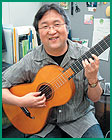It is still uncommon for most Japanese scientists to take such steps, but Dr. Kazuo Okanoya is no common Japanese scientist. Having earned his Ph.D. outside of Japan-at the University of Maryland, he has seen the cultural differences in science. He shares his thoughts about the realities and joys of a career in science in Japan, here.
Q: How would you characterize a typical Japanese scientist?
A: In Japan, there are researchers who approach science as Americans and those who approach it as Japanese. The stereotypical scientist discovers what she wants to know and then spend the rest of her life pursuing that dream. However, these dreams are not pursued in the United States unless an acceptable market for that dream is found. That is, a typical American scientist develops a strategy to sell their science, before doing science. There are limits to this approach, however, especially in relation to creativity.
A Japanese trained scientist has a less structured approach to research. Therefore, a Japanese scientist often has a more difficult time developing a new idea or seeing the bigger picture behind a research question. While researchers in the US attempt to focus their projects within broadly understood perspectives to give them a stronger advantage, the typical Japanese post-doctorate has difficulty either finding that focus or communicating it.
Q: Having such a difference in training must have made it hard to reintegrate into Japanese academia. How did you manage to adjust?
A: I had to take three post-doctorates before I landed a position at Chiba University. I think that might be because I had learned to be aggressive in the United States and because I had no connections in Japan to help me.
Q: Aggressive?
A: Yeah, in the US I learned that a researcher must be provocative-to challenge any idea or finding aggressively and discuss concepts thoroughly. So I developed an arrogant attitude to survive that I brought home to Japan. I would brazenly challenge anyone regardless of position. As a result, my colleagues said I had a nasty attitude. Looking back, I think this was probably a good way to ensure that I would be recognized.
Q: Dr. Okanoya, you were a teaching assistant for three years at the University of Maryland and later taught as a professor at Chiba University, did you notice any differences between Japanese and American students?
A: Oh, the interest in grades! American students pay more attention to the mark they received, than to the material, while my Japanese students seemed more interested in the subjects. Yet, the Japanese students and post-docs are less assertive.
I guess it boils down to story. Having a vision and creating a unique story is increasingly important for research success. While I find Japanese students and post-docs to be creative, especially when developing new techniques or methods of investigation, it is not easy to evaluate. Developing an idea and an investigative plan to test that idea requires seeing the broader picture. It is the marketing of science.
Q: So we come back to marketing. Do you think a lack of communication skills is cultural and therefore insurmountable?
A: I have a large lab and limited space. There are no assigned desks. The desks with computers are available on a first-come basis. There is rarely a problem with demand and supply. Interestingly, this open office system has had real benefits. Communication between lab members has increased. In the right settings, effective communication happens.
Q: Can you demonstrate your skill as a communicator by sharing how you discovered your research dream?
A: It started when I was four or five when death became a very real concern for me. I asked my mother if I was going to die, and she laughed and looked at me strangely. I started to wonder why I am strange, and I wanted to know what makes me strange. My interest in them mind and the essence of humanity probably began there and motivated my desire to understand the biological basis of language. I investigated the way young birds learn syntactical patterns in birdsong and showed how sexual selectivity and the impact of sex selection on the basal ganglia drive language development. That is, I showed that female birds prefer male birds that got rhythm.
Mammalian brains are very different, however, so I have expanded my research to include naked mole rats and degues. Both the rodents are highly social and vocal, but in different ways. Naked mole rats have at least eighteen distinct vocalizations that convey information to others that alters behaviour. Degues are also highly social rodents, but like male birds, male degues woo their mates through song. By studying these creatures, we may be able to see how semantic meaning emerges from syntactical patterns and I can observe how behaviour differences in these animals might indicate semantic meaning.






